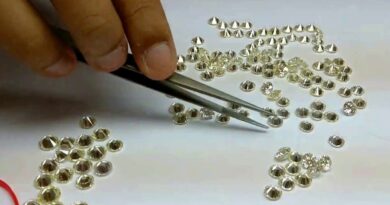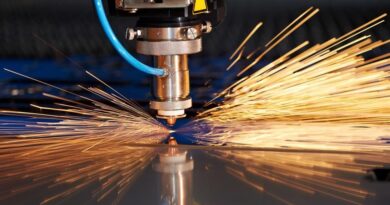Product Development Manager
SECTOR: GEMS & JEWELLERY
SUB-SECTOR: Cast and Diamonds-Set Jewellery
OCCUPATION: Designing and Product Development
REFERENCE ID: G&J/Q2305
ALIGNED TO: NCO-2004/ NIL
Product Development (PD) Manager: Also known as ‘PD Head’ in the jewellery
manufacturing industry, the PD Manager is in-charge of the product
development department and plays critical role in the jewellery designing and
development.
Brief Job Description: The individual at work coordinates with the
stakeholders such as customers, marketing team, production team, designers
and merchandisers to develop the practical, marketable and fashionable
jewellery products. The individual recruits, trains and manages team of
designers.
Personal Attributes: The job requires the individual to have: ability to manage
team. The individual must be creative and fashion conscious and have:
attention to details and presentation skills and willingness to travel
extensively. The individual must also have analytical skills to assess the market
trends.
Unit Code G&J/N2305
Unit Title
(Task) Develop jewellery products
Description This OS unit is about developing jewellery products at different price points by
assessing market trends for practical, marketable and fashionable designs
Scope This unit/task covers the following:
Assess the market trends
conduct research for the trends and market preferences for the types of jewellery
products and designs
interact with customers, marketing department and merchandiser to gain market
understanding
follow various jewellery design publications, exhibitions, etc. to understand new
design trends
hypothesise for the new designs required at different price points
Provide design brief to merchandiser and designer
explain the criticality and complexity of designs to merchandiser and designers
instruct designers on product type, size, dimensions, shapes, materials
describe the final outcome as desired by the customer or as per plan
quality check the hand sketch and CAD designs and suggest improvements
Present the designs to senior management
prepare design brief in terms of uniqueness, practicality, potential in the market
and price points
give presentation of the design concepts
incorporate the design changes suggested by marketing and production heads
finalise the designs
Prepare and implement product development plan
prepare the product development plan for specific season, exhibitions, customers
and/or market
describe the selected designs and jobs expected from designers and CAM operator
for preparing master model in resin
coordinate with production manager and get the metal master produced
provide quality improvement inputs to production department
receive inputs from customer and marketing department for improvements in
product designs
finalise the master model
Marketing support
present the new products to the marketing team
jointly showcase products to the customers and in exhibitions
select designs for running marketing campaign, catalogues
resolve customer queries
Managing Team
plan for capacity expansion and recruiting designers
train and mentor the designers
allocate work and monitor the work flow
assess and appraise the performance of the team members
approve the training plan and administrative requirements of the team members
Report problems related to:
practicality and marketability of designs
mismatch in design concept in terms of design trends, customer requirement,
production limitations and the appropriate action to take if refinement or
modification are required
reasons for anticipated delays that may adversely affect delivery
Performance Criteria (PC) w.r.t. the Scope
Element Performance Criteria
Managing team To be competent, the user/individual on the job must be able to:
PC1. accurately assess designer’s capabilities and work load in order to distribute
work for maximum productivity
PC2. ensure overall performance of the team
PC3. accurately plan for capacity expansions
PC4. impart quality training for the team members
PC5. anticipate and alert about any disruptions and worker’s capabilities
PC6. resolve team member grievances
Develop jewellery
products
To be competent, the user/individual on the job must be able to:
PC7. plan and implement product development plan
PC8. identify product categories at different price points
PC9. accurately estimate price points of the new products
PC10. create collections for the specific season, exhibitions, customers and/or
market
PC11. ensure timely delivery of product samples to marketing department
PC12. create new successful jewellery products per year
Productivity To be competent, the user/individual on the job must be able to:
PC13. make timely delivery of jewellery products for launching in the market
PC14. develop number of successful products as per target given
PC15. ensure defect free output with minimal hazards
Quality of output To be competent, the user/individual on the job must be able to:
PC16. showcase products with unique and appealing design within the range of
price points
PC17. synchronise products based on inputs from marketing and production
department
G&J/N2305 Develop jewellery products
6
Knowledge and Understanding (K)
A. Organizational
Context
The user/individual on the job needs to know and understand:
KA1. company’s policies on: quality, incentives, delivery standards, safety and
hazards, integrity and IPR, and personnel management
KA2. work flow involved in cast and diamond-set jewellery manufacturing
KA3. importance of the individual’s role in the workflow
KA4. reporting structure
KA5. typical customer profile of the company
KA6. specialisation of the company (product type, designs, etc. )
B. Technical
Knowledge
The user/individual on the job needs to know and understand:
KB1. how to use computers, CorelDRAW, CAD workstation software and hardware,
compact digital camera, MS office, data management software, internet, etc.
KB2. basic principles of drawing jewellery shapes
KB3. different type of jewellery products rings, bracelets, pendants, necklace, etc.
KB4. different types of diamonds and/or gemstones, colours, cuts and shapes
KB5. utility of designs in terms of daily wear, occasional
KB6. manufacturing drawing conventions
KB7. basic manufacturing and techniques including types of diamonds and/or
gemstones settings
KB8. basics of design techniques, tools, principle involved in production of precision
designs, blueprints, drawings, and models
Skills (S) [Optional]
A. Core Skills/
Generic Skills
Basic reading and writing skills
The user/ individual on the job needs to know and understand how to:
SA1. read notes, designs and instructions in terms of design concepts
SA2. read company rules and compliance documents required to complete the work
Calculation and Geometry skills
The user/individual on the job needs to know and understand how to:
SA3. count the number of diamonds and gemstones and weight of gold and other
materials
SA4. assess accuracy of alignment and measure symmetry
SA5. mathematical calculations used in design
Pricing mechanism
The user/individual on the job needs to know and understand how to:
SA6. track prices for precious metal, diamond and gemstones prices
SA7. estimate the manufacturing prices as per complexity of designs
SA8. determining price points for new designs based on gold weight, diamond carat
Team management
The user/individual on the job needs to know and understand how to:
SA9. assess and appraise team members’ performance
SA10. plan for capacity expansions
SA11. train and motivate team members
B. Professional Skills Creative thinking
The user/individual on the job needs to know and understand:
SB1. visualisation of designs
SB2. fashion trends for jewellery designs
SB3. translation of design ideas/concepts to jewellery product
Photography skills
The user/individual on the job needs to know and understand:
SB4. how to use compact digital cameras
SB5. photography for jewellery design concepts and visualisations
Reflective thinking
The user/individual on the job needs to know and understand how to:
SB6. improve ratio of successful designs
SB7. improve work processes or greater productivity
SB8. pre-empt complexity of the design in order to increase the speed of designs
SB9. judging the market potential of the jewellery products
SB10. suggesting necessary design changes for practicality and maintaining look of
the jewellery designs
Critical thinking
The user/individual on the job needs to know and understand how to:
SB11. anticipate process disruption and reasons for delay
Unit Code G&J/N9901
Unit Title
(Task) Maintain IPR of company and respect IPR of other companies
Description This OS unit is about protecting company’s IPR and avoiding infringement to IPR of
other companies
Scope This unit/task covers the following:
Protect company’s Intellectual Property Rights (IPR)
prevent leak of new designs to competitors by reporting on time
be aware of any of company’s product or design patents
report IPR violations observed in the market, to supervisor or company heads
Avoid infringement to IPR of other companies
read copyright clause of the material published on the internet and any other
printed material
consult supervisor or senior management when in doubt about using publicly
available information
report any infringement observed in the company
Element Performance Criteria
Respecting and
Maintaining IPR
To be competent, the user/individual on the job must:
PC1. be able to spot plagiarism and report
PC2. be aware of patents and IPR
PC3. not be involved in IPR violations
Knowledge and Understanding (K)
A. Organizational
Context
The user/individual on the job needs to know and understand:
KA1. company’s policies on IPR and plagiarism
KA2. reporting structure
KA3. company’s unique product range
B. Technical
Knowledge
The user/individual on the job needs to know and understand:
KB1. patents and IPR laws
KB2. how IPR protection is important for competitiveness of a company
Skills (S) [Optional]
A. Core Skills/
Generic Skills
Communication skills
The user/ individual on the job needs to know and understand how to:
SA1. effectively communicate any observed IPR violations or order leaks
B. Professional Skills Decision making
The user/individual on the job needs to know and understand how to:
SA2. report potential sources of violations
Reflective thinking
The user/individual on the job needs to know and understand to:
SA3. learn from past mistakes and report IPR violations on time
Critical thinking
The user/individual on the job needs to know and understand how to:
SA4. spot signs of violations and alert authorities in time
Unit Code G&J/N9904
Unit Title
(Task) Coordinate with various stakeholders for product development
Description This OS unit is about communicating with colleagues, seniors and customers in order
to achieve smooth and hazard-free work flow
Scope This unit/task covers the following:
Interact with product development department
receive work instructions and design inputs from reporting supervisor
discuss the product development plan
communicate to reporting supervisor about process-flow improvements,
product defects received from previous process, repairs and maintenance of
tools and machinery as required
communicate any potential hazards or expected process disruptions
present the design brief
Interact with marketing department
receive instructions and design inputs
get market data, competitors information and inputs on market trend
understand customer requirement and modifications in design
present design brief
collaborate for developing marketing campaigns
Interact with production manager
provide design briefs and product details for jewellery pieces to be
manufactured
share product development plan
receive inputs from designers and production department for improvements in
product designs
Interact with colleagues within and outside the department
work as a team with colleagues and share work as per their or own work load
and skills
give instructions to designers in terms of product type, size, dimensions, shapes,
materials
work with colleagues of other departments
communicate an discuss work flow related difficulties in order to find solutions
with mutual agreement
give feedback to designers
coordinate with CAM operator and get resin master model produced
Interact with customers
understand customer requirements
give proposals to customers
solve customer queries regarding modifications in designs
Performance Criteria(PC) w.r.t. the Scope
Element Performance Criteria
Interaction with
product development
department
To be competent, the user/individual on the job must be able to:
PC1. understand the work output requirements
PC2. comply with company policy and rule
PC3. deliver quality work on time as required by reporting any anticipated reasons
for delays
Interactions with
colleagues and other
departments
To be competent, the user/individual on the job must be able to:
PC4. put team over individual goals
PC5. resolution conflicts among team members as well as other departments
PC6. multi-task activities involved in the product development
Interaction with
marketing
department and
customers
To be competent, the user/individual on the job must be able to:
PC7. understand the jewellery design trends
PC8. understand customer requirement
PC9. resolve customer queries and provide quality output
Knowledge and Understanding (K)
A. Organizational
Context
The user/individual on the job needs to know and understand:
KA1. company’s policies on: acceptable limits of gold loss, incentives, delivery
standards, safety and hazards, integrity and IPR, and personnel management
KA2. work flow involved in cast and diamond-set jewellery manufacturing of
company
KA3. importance of the individual’s role in the workflow
KA4. reporting structure
B. Technical
Knowledge
The user/individual on the job needs to know and understand how to:
KB1. communicate effectively
KB2. build team coordination
Skills (S) [Optional]
A. Core Skills/
Generic Skills
Teamwork and multitasking
The individual on the job needs to know and understand how:
SA1. to share work load as required
SA2. to deliver product to next work process on time
B. Professional Skills Decision making
The individual on the job needs to know and understand:
SB1. potential areas of disruptions to work process and report the same
SB2. when to report to supervisor and when to deal with a colleague individually,
depending on the type of concern
Reflective thinking
The individual on the job needs to know and understand how to:
SB3. improve work processes
nate with various stakeholders related to product development
16
Critical thinking
The individual on the job needs know and understand how to:
SB4. spot process disruptions and delays
Unit Code G&J/N9905
Unit Title
(Task) Maintain occupational health and safety
Description This OS unit is about being aware of, communicating and taking steps towards
minimizing potential hazards and dangers of accidents on the job and maintaining
occupational health and safety
Scope This unit/task covers the following:
Understand potential sources of accidents
to avoid accidents related to use of potentially dangerous chemicals, sharp tools
and machines
Use safety gear to avoid accidents
wear safety gear such as goggles, mask, gloves, ear plugs
Actively participate in the health and safety awareness campaigns
attend fire drills organised by the company or industrial zone
learn first aid procedure
be alert about designated assembly area in the event of an emergency
read and understand the evacuation and emergency procedures
Communicate to reporting supervisor about:
process flow improvements that can reduce anticipated or repetitive hazards
mishandling of tools, machines or hazardous materials
electrical problems that could result in accident
Element Performance Criteria
Communicating
potential accident
points
To be competent, the user/individual on the job must be able to:
PC1. spot and report potential hazards on time
PC2. follow company policy and rules regarding use of hazardous materials
PC3. attend and actively participate in the health and safety campaigns organised
by the company
Using safety gear To be competent, the user/individual on the job must be able to:
PC4. use or wear safety gear as per the rules of the company
Knowledge and Understanding (K)
A. Organizational
Context
The user/individual on the job needs to know and understand:
KA1. company’s policies on: safety and hazards and personnel management
KA2. reporting structure
B. Technical
Knowledge
The user/individual on the job needs to know and understand:
KB1. how different chemicals react and what could be the danger from them
KB2. how to use machines and tools without suffering bodily harm
Skills (S) [Optional]
A. Core Skills/
Generic Skills
Communication skills
The individual on the job needs to know and understand how to:
SA1. effectively communicate the danger
Organising skills
The individual on the job needs to know and understand how to:
SA2. keep all the tools in an organised manner so as to avoid accidents
SA3. keep the work environment safe and clean
B. Professional Skills Decision making
The individual on the job needs to know and understand how to:
SB1. report potential sources of danger
SB2. follow prescribed procedure in the event of an accident
SB3. wear appropriate safety gear to avoid an accident
Reflective thinking
The individual on the job needs to know and understand to:
SB4. learn from past mistakes regarding use of hazardous machines or chemicals
Critical thinking
The individual on the job needs to know and understand how to:
SB5. spot danger
Decision making
The individual on the job needs to know and understand how to:
SB6. report potential sources of danger
SB7. follow prescribed procedure in the event of an accident
SB8. wear appropriate safety gear to avoid an accident
Keywords /Terms Description
Sector Sector is a conglomeration of different business operations having similar
business and interests. It may also be defined as a distinct subset of the
economy whose components share similar characteristics and interests.
Sub-sector Sub-sector is derived from a further breakdown based on the
characteristics and interests of its components.
Occupation Occupation is a set of job roles, which perform similar/ related set of
functions in an industry.
Function Function is an activity necessary for achieving the key purpose of the
sector, occupation, or an area of work, which can be carried out by a
person or a group of persons. Functions are identified through functional
analysis and form the basis of OS.
Sub-function Sub-functions are sub-activities essential to fulfil the achieving the
objectives of the function.
Job role Job role defines a unique set of functions that together form a unique
employment opportunity in an organisation.
Occupational Standards
(OS)
OS specify the standards of performance an individual must achieve
when carrying out a function in the workplace, together with the
knowledge and understanding they need to meet that standard
consistently. Occupational Standards are applicable both in the Indian
and global contexts.
Performance Criteria Performance criteria are statements that together specify the standard of
performance required when carrying out a task.
National Occupational
Standards (OS)
NOS are occupational standards which apply uniquely in the Indian
context.
Qualifications Pack (QP) QP comprises the set of OS, together with the educational, training and
other criteria required to perform a job role. A QP is assigned a unique
qualifications pack code.
Unit Code Unit code is a unique identifier for an Occupational Standard, which is
denoted by an ‘N’
Unit Title Unit title gives a clear overall statement about what the incumbent
should be able to do.
Description Description gives a short summary of the unit content. This would be
helpful to anyone searching on a database to verify that this is the
appropriate OS they are looking for.
Scope Scope is a set of statements specifying the range of variables that an
individual may have to deal with in carrying out the function which have
a critical impact on quality of performance required.
Knowledge and
Understanding
Knowledge and understanding are statements which together specify the
technical, generic, professional and organisational specific knowledge
that an individual needs in order to perform to the required standard.
Organisational Context Organisational context includes the way the organisation is structured
and how it operates, including the extent of operative knowledge
managers have of their relevant areas of responsibility.
Technical Knowledge Technical knowledge is the specific knowledge needed to accomplish
specific designated responsibilities.
Core Skills/ Generic
Skills
Core skills or generic skills are a group of skills that are the key to learning
and working in today’s world. These skills are typically needed in any
work environment in today’s world. These skills are typically needed in
any work environment. In the context of the OS, these include
communication related skills that are applicable to most job roles.
Keywords /Terms Description
CAD Computer Aided Design
CAM Computer Aided Manufacturing
IPR Intellectual Property Rights
NOS National Occupational Standard(s)
NVQF National Vocational Qualifications Framework
NSQF National Qualifications Framework
NVEQF National Vocational Education Qualifications Framework
QP Qualifications Pack
CRITERIA FOR ASSESSMENT OF TRAINEES
Job Role Qualifications Pack- Product Development Manager
Qualification Pack Qualifications Pack- Product Development Manager
Sector Skill Council
GEMS & JEWELLERY
Assessment Strategy Marks Allocation
NOS Elements Performance Criteria Theory Practical
- G&J/N2305 Develop
jewellery products
Managing team
PC1. accurately assess designer’s capabilities and work load in order to distribute work
for maximum productivity 1 5
PC2. ensure overall performance of the team 0 5
PC3. accurately plan for capacity expansions 1 5
PC4. impart quality training for the team members 0 5
PC5. anticipate and alert about any disruptions and worker’s capabilities 1 5
PC6. resolve team member grievances 1 5
Develop jewellery
products
PC7. plan and implement product development plan 0 5
PC8. identify product categories at different price points 1 5
PC9. accurately estimate price points of the new products 1 5
PC10. create collections for the specific season, exhibitions, customers and/or market 1 5
PC11. ensure timely delivery of product samples to marketing department 0 4
PC12. create new successful jewellery products per year 0 4
Productivity
PC13. make timely delivery of jewellery products for launching in the market 0 2
PC14. develop number of successful products as per target given 0 2
PC15. ensure defect free output with minimal hazards 0 2
Quality of output
PC16. showcase products with unique and appealing design within the range of price
points 0 3
PC17. synchronise products based on inputs from marketing and production
department 0 3
7 70 - G&J/N9901 Respect and
maintain IPR
Respecting and
Maintaining IPR
PC1. be able to spot plagiarism and report 1 0
PC2. be aware of patents and IPR 1 0
PC3. not be involved in IPR violations 1 0
3 0
- G&J/N9904 Coordinate
with various stakeholders
related to product
development
Interaction with product
development department
PC1. understand the work output requirements 1 1
PC2. comply with company policy and rule 1 0
PC3. deliver quality work on time as required by reporting any anticipated reasons for
delays 1 1
Interactions with
colleagues and other
departments
PC4. put team over individual goals 1 0
PC5. resolution conflicts among team members as well as other departments 1 0
PC6. multi-task activities involved in the product development 1 0
Interaction with
marketing department
and customers
PC7. understand the jewellery design trends 0 1
PC8. understand customer requirement 0 1
PC9. resolve customer queries and provide quality output 0 2
6 6 - G&J/N9905 Maintain
occupational health and
safety
Communicating potential
accident points
PC1. spot and report potential hazards on time 1 0
PC2. follow company policy and rules regarding use of hazardous materials 1 2
PC3. attend and actively participate in the health and safety campaigns organised by
the company 1 0
Using safety gear PC4. use or wear safety gear as per the rules of the company 1 2
4 4
20 80
100








